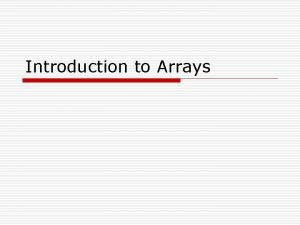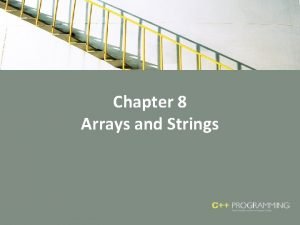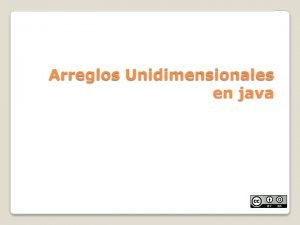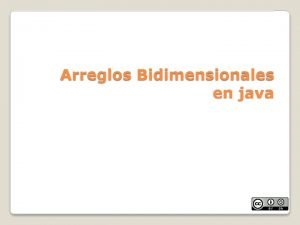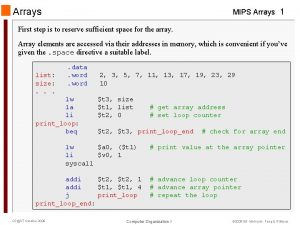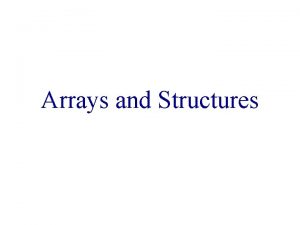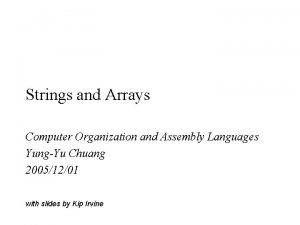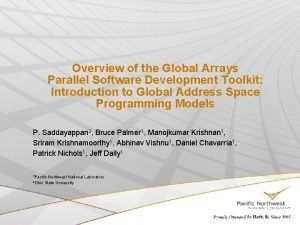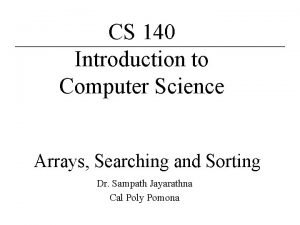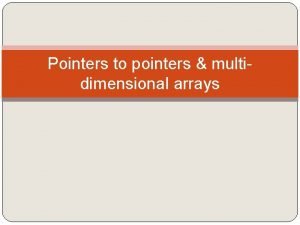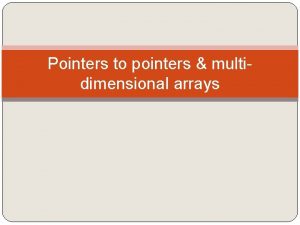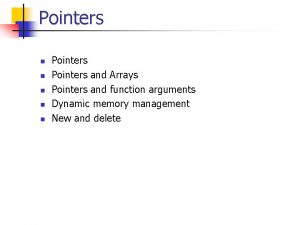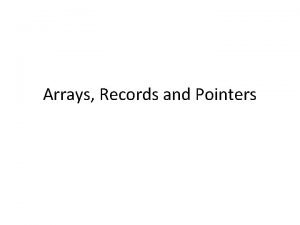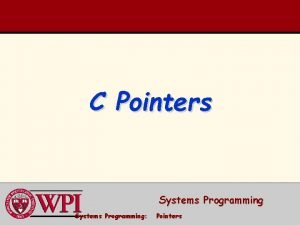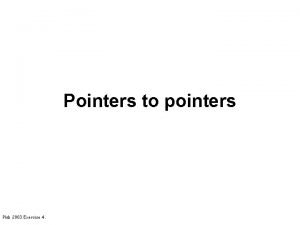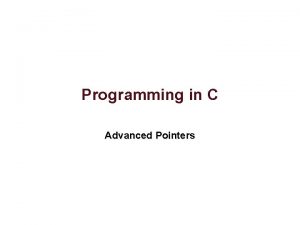Pointers and Arrays 1 Pointers and Arrays n


![Example n n Consider the declaration: int x[5] = {1, 2, 3, 4, 5}; Example n n Consider the declaration: int x[5] = {1, 2, 3, 4, 5};](https://slidetodoc.com/presentation_image_h2/c943b57ab2e1fe1dcaef67a6142dfe67/image-3.jpg)

![n n Relationship between p and x: p = &x[0] = 2500 p+1 = n n Relationship between p and x: p = &x[0] = 2500 p+1 =](https://slidetodoc.com/presentation_image_h2/c943b57ab2e1fe1dcaef67a6142dfe67/image-5.jpg)
![Example: function to find average int main() { int x[100], k, n; scanf (“%d”, Example: function to find average int main() { int x[100], k, n; scanf (“%d”,](https://slidetodoc.com/presentation_image_h2/c943b57ab2e1fe1dcaef67a6142dfe67/image-6.jpg)









- Slides: 15

Pointers and Arrays 1

Pointers and Arrays n When an array is declared, ¨ The compiler allocates sufficient amount of storage to contain all the elements of the array in contiguous memory locations ¨ The base address is the location of the first element (index 0) of the array ¨ The compiler also defines the array name as a constant pointer to the first element 2
![Example n n Consider the declaration int x5 1 2 3 4 5 Example n n Consider the declaration: int x[5] = {1, 2, 3, 4, 5};](https://slidetodoc.com/presentation_image_h2/c943b57ab2e1fe1dcaef67a6142dfe67/image-3.jpg)
Example n n Consider the declaration: int x[5] = {1, 2, 3, 4, 5}; Suppose that each integer requires 4 bytes Compiler allocates a contiguous storage of size 5 x 4 = 20 bytes Suppose the starting address of that storage is 2500 Element x[0] x[1] x[2] x[3] x[4] Value 1 2 3 4 5 Address 2500 2504 2508 2512 2516 3

Contd. n The array name x is the starting address of the array ¨ Both x and &x[0] have the value 2500 ¨ x is a constant pointer, so cannot be changed n X = 3400, x++, x += 2 are all illegal n If int *p is declared, then p = x; n and p = &x[0]; are equivalent We can access successive values of x by using p++ or p-- to move from one element to another 4
![n n Relationship between p and x p x0 2500 p1 n n Relationship between p and x: p = &x[0] = 2500 p+1 =](https://slidetodoc.com/presentation_image_h2/c943b57ab2e1fe1dcaef67a6142dfe67/image-5.jpg)
n n Relationship between p and x: p = &x[0] = 2500 p+1 = &x[1] = 2504 In general, *(p+i) gives p+2 = &x[2] = 2508 the value of x[i] p+3 = &x[3] = 2512 p+4 = &x[4] = 2516 C knows the type of each element in array x, so knows how many bytes to move the pointer to get to the next element 5
![Example function to find average int main int x100 k n scanf d Example: function to find average int main() { int x[100], k, n; scanf (“%d”,](https://slidetodoc.com/presentation_image_h2/c943b57ab2e1fe1dcaef67a6142dfe67/image-6.jpg)
Example: function to find average int main() { int x[100], k, n; scanf (“%d”, &n); for (k=0; k<n; k++) scanf (“%d”, &x[k]); float avg (int array[], int size) { int *p, i , sum = 0; p = array; printf (“n. Average is %f”, avg (x, n)); return 0; for (i=0; i<size; i++) sum = sum + *(p+i); } return ((float) sum / size); } 6

The pointer p can be subscripted also just like an array! int main() { int x[100], k, n; scanf (“%d”, &n); float avg (int array[], int size) { int *p, i , sum = 0; for (k=0; k<n; k++) scanf (“%d”, &x[k]); p = array; for (i=0; i<size; i++) sum = sum + p[i]; printf (“n. Average is %f”, avg (x, n)); return 0; } return ((float) sum / size); } 7

Important to remember n Pitfall: An array in C does not know its own length, & bounds not checked! ¨ Consequence: While traversing the elements of an array (either using [ ] or pointer arithmetic), we can accidentally access off the end of an array (access more elements than what is there in the array) ¨ Consequence: We must pass the array and its size to a function which is going to traverse it, or there should be some way of knowing the end based on the values (Ex. , a –ve value ending a string of +ve values) n Accessing arrays out of bound can cause segmentation faults ¨ Hard to debug (already seen in lab) ¨Always be careful when traversing arrays in programs 8

Pointers to Structures 9

Pointers to Structures Pointer variables can be defined to store the address of structure variables n Example: n struct student { int roll; char dept_code[25]; float cgpa; }; struct student *p; 10

n Just like other pointers, p does not point to anything by itself after declaration ¨ Need to assign the address of a structure to ¨ Can use & operator on a struct student type p variable ¨ Example: struct student x, *p; scanf(“%d%s%f”, &x. roll, x. dept_code, &x. cgpa); p = &x; 11

n Once p points to a structure variable, the members can be accessed in one of two ways: ¨ (*p). roll, n ¨p Note the ( ) around *p –> roll, p –> dept_code, p –> cgpa n n (*p). dept_code, (*p). cgpa The symbol –> is called the arrow operator Example: ¨ printf(“Roll = %d, Dept. = %s, CGPA = %fn”, (*p). roll, (*p). dept_code, (*p). cgpa); ¨ printf(“Roll = %d, Dept. = %s, CGPA = %fn”, p->roll, p->dept_code, p->cgpa); 12

Pointers and Array of Structures n Recall that the name of an array is the address of its 0 -th element ¨ Also true for the names of arrays of structure variables. n Consider the declaration: struct student class[100], *ptr ; 13

n n The name class represents the address of the 0 -th element of the structure array ¨ ptr is a pointer to data objects of the type struct student The assignment ptr = class; will assign the address of class[0] to ptr Now ptr->roll is the same as class[0]. roll. Same for other members When the pointer ptr is incremented by one (ptr++) : ¨ The value of ptr is actually increased by sizeof(struct student) ¨ It is made to point to the next record ¨ Note that sizeof operator can be applied on any data type 14

A Warning n When using structure pointers, be careful of operator precedence ¨ Member operator “. ” has higher precedence than “*” n ptr –> roll and (*ptr). roll mean the same thing n *ptr. roll will lead to error ¨ The operator “–>” enjoys the highest priority among operators n ++ptr –> roll will increment ptr->roll, not ptr n (++ptr) –> roll will access (ptr + 1)->roll (for example, if you want to print the roll no. of all elements of the class array) 15
 Dynamic arrays and amortized analysis
Dynamic arrays and amortized analysis Searching and sorting arrays in c++
Searching and sorting arrays in c++ Advantages and disadvantages of array
Advantages and disadvantages of array Parallel array java
Parallel array java Array of arrays c++
Array of arrays c++ Parallel arrays
Parallel arrays Veteork
Veteork Parallel arrays
Parallel arrays Why do we need arrays?
Why do we need arrays? Vectores unidimensionales ejemplos
Vectores unidimensionales ejemplos Arrays bidimensionales java
Arrays bidimensionales java Mips arrays
Mips arrays Polynomial representation using arrays
Polynomial representation using arrays Strings in assembly language
Strings in assembly language Global arrays in c
Global arrays in c Computer science arrays
Computer science arrays





